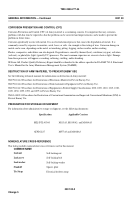TM-9-2350-277-34 - Page 43 of 871
TM 9-2350-277-34
THEORY OF OPERATION — Continued
0003 00
The variable speed fan drive system is designed to modulate the cooling fan speed to maintain relatively constant coolant
temperatures despite vehicle load or ambient temperature. The cooling fan speed is controlled by the fan drive assembly.
The fan drive assembly is driven by the engine crankshaft through a splined coupling. The fan drive assembly contains a
multi-plate clutch pack which regulates the fan drive output speed. In the old variable speed fan drive configuration, the
thermostatic control valve senses engine coolant temperature and regulates the hydraulic pressure to the fan drive assembly
clutch pack. The higher the coolant temperature, the higher the hydraulic pressure which will result in less clutch slip and
higher fan speed. The new variable speed fan drive configuration is electromagnetically controlled. The new configuration
uses the same process of changing pressure plates, locking up or releasing to speed up or slow down the fan. The variable
speed fan drive is electromagnetically regulated by the electronic controller which receives information from switches
and sensors. This allows the cooling system to operate efficiently so full power is not required. The electronic controller
has diagnostic capability to help the crew and maintenance personnel in troubleshooting the variable speed fan drive and
cooling system.
The surge tank acts as an overflow tank to keep the cooling system from overpressurizing. It also removes air from the engine
coolant. There is a low coolant level transmitter to signal the operator if more coolant is needed.
ENGINE AIR SYSTEM
The engine air system allows air to enter the engine. The air cleaner cleans air that enters the engine. Dust is drawn out
through a scavenge outlet. Air is filtered through a reusable filter element before deliverytotheengine
.Anairfilter
indicator shows when the element is clogged and needs cleaning or replacing. After being filtered, the air moves through
the turbocharger and into the engine cylinders.
AUXILIARY AUTOMOTIVE SYSTEMS
The auxiliary automotive systems include driver controls, fuel cells, personnel heater, and bilge pumps. Also there is a crew
ventilation system, and fire suppression system.
DRIVER CONTROLS
The driver controls regulate the engine, transmission, and steering braking systems of the carrier.
The fuel shutoff control is used to stop the supply of fuel to the fuel pump. To start the engine, the driver must open the
valve. The throttle linkages are used to control the engine speed. The gear selector allows the driver to choose the proper
gear for the carrier. The steering system controls the carrier direction. The steering control consists of a steering yoke and
linkage connected to the transmission.
The brake system allows the driver to stop a moving carrier and hold the carrier in position. The braking system consists
of the service brake and the parking brake. The service brakes are hydraulicandappliedbypedal
.Theparkingbrake
mechanically locks the transmission to prevent carrier movement. Also, the system has levers, rods, shafts, and linkages
connecting to the transmission brake shaft.
FUEL TANKS
Diesel fuel is stored in two separate fuel tanks. They are located on the back of the carrier hull. The fuel is drawn from
the fuel tanks through the primary fuel filter by the fuel pump. The fuel then flows through the secondary fuel filter to the
injectors. The injectors regulate the amount of fuel that enters the engine.
PERSONNEL HEATER
The personnel heater system provides heat inside the carrier. Major parts are the combination combustion chamber/heat
exchanger, blowers, a fuel pump, and an electrical control and safety system. The heater operates using diesel fuel drawn from
the fuel tanks. Fuel is delivered to the combustion chamber from the fuel pump. Outside air is drawn into the combustion
chamber by one of the blowers. A blower draws air from the crew compartment into the combustion chamber. The air is
warmed by heat from the combustion process and then returned to the crew compartment.
0003 00-2
Change 2
Back to Top




















